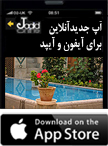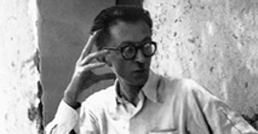Sadeq Hedayat is considered to be one of the most original and creative Iranian writers of the twentieth century. His unusual imagination and penetrating criticism of society endeared him to many in Iran and beyond.
Born in Tehran in 1903, he was among those students selected to go Europe to further their studies. Embracing European culture he quickly began to absorb the works of modern European writers, became fluent in French, and stayed for four years in Belgium and France until 1930.
After his return to Tehran he was employed in minor administrative or clerical positions, but at once began to publish a series of outstanding collections of short stories, historical plays, and novella. The most important of these, widely regarded as his masterpiece, was The Blind Owl, completed during a short visit to Bombay in 1936, where it was first published privately.
Together with his interest in modern European literature, he was also deeply influenced by ancient Iran and its cultural history, folklore, as well as Omar Khayyam and vegetarianism, subjects of his first publications that remained constant themes throughout his life.
Hedayat’s literary reputation, after his suicide in Paris during a second brief visit to France in 1951, has suffered the usual peaks and troughs of popularity. The romantic ideas of Iranian nationalism that blamed the Arab conquest of the 7th century for Iran’s twentieth century problems struck a cord with some in the later Pahlavi period, whilst his criticism of corrupt conservative politicians in works such as Haji Aqa and his trenchant satire of some aspects of traditional religious culture in Tup-e Moravid and in short stories like Talab-e Amorzesh, ensured his stature amongst the secular liberal Left. But in turn, neither of these aspects of his work endeared him to the post-revolutionary leaders of Iran.
It was only in the 1990’s that he again became a topic for debate and discussion amongst the intelligentsia and to some extent a wider public. Hedayat’s works were re-issued and critical studies of his role in the development of modern literature began to be published. This trend was enhanced by the celebration of the centenary of his birth both within the country and abroad. International conferences devoted entirely to a study of his life and works, and a book of photographs and a collection of his postcards were edited and published by his nephew Jahangir Hedayat, the son of his brother Mahmud to whom most of these postcards and letters had been sent. The account of another brother, Isa, of the last days of Hedayat before his suicide was also published, suggesting a more intimate and personal view of his personality than had been previously seen.
It was the desire to commemorate this aspect of Hedayat that provided the inspiration for the attempt in the 1970’s to purchase the Hedayat family’s old house and create a museum in his memory. It was hoped that a display of memorabilia, photographs, drafts of his works, and some of his personal possessions, together with his writing desk, would be a fitting memorial to Iran’s most celebrated twentieth century writer. However, these efforts coincided with the revolution of 1979 and the plan was abandoned.
After the revolution, the house was handed over to a local hospital and then later to the University of Medical Sciences. The hospital turned the house into a nursery where children would draw rabbits, bears and the brave boy on its walls. The courtyard became a playground.
Although the media began a campaign to have the house turned into a museum, this has never been achieved and Iran still has no home for Hedayat’s personal memorabilia and no means of celebrating one of its greatest authors. A further recent set-back was the publication of a censored edition of The Blind Owl, though most of his other works are still available in their original form.
In the Multimedia report on this page Jahangir Hedayat discusses Sadeq Hedayat’s personal possessions and the house which almost became a museum.
 Like us on Facebook
Like us on Facebook
Share this story


